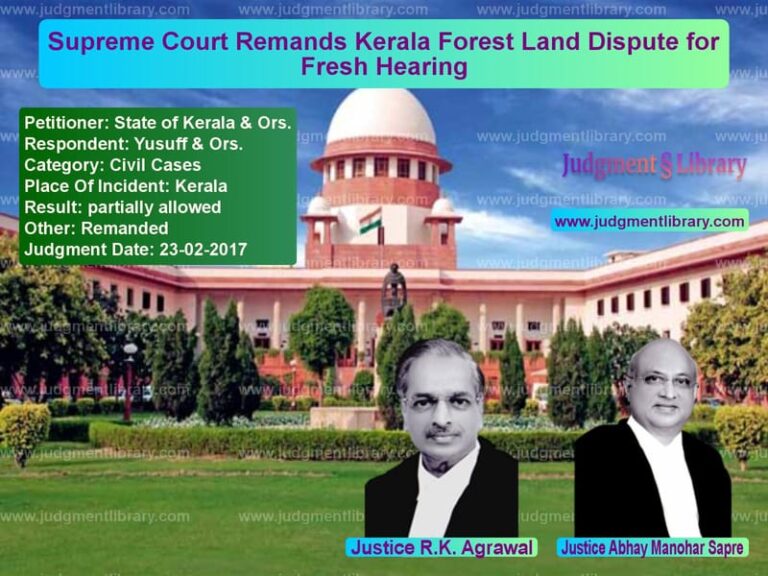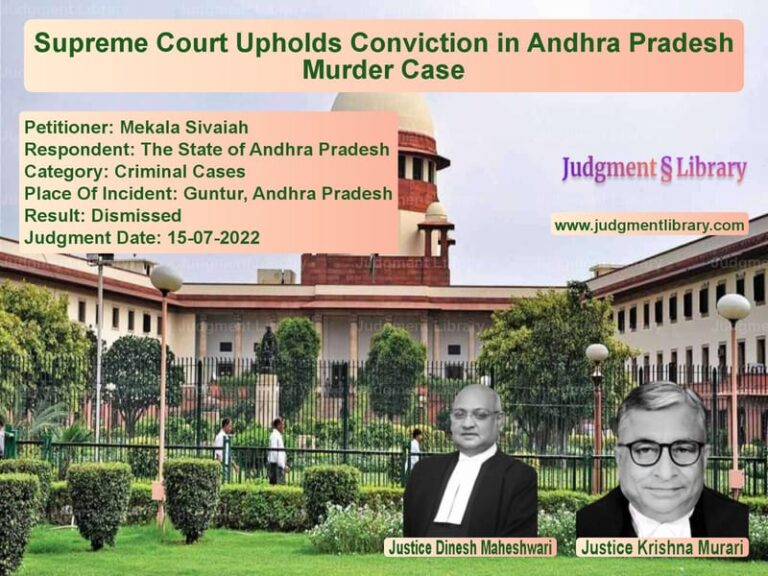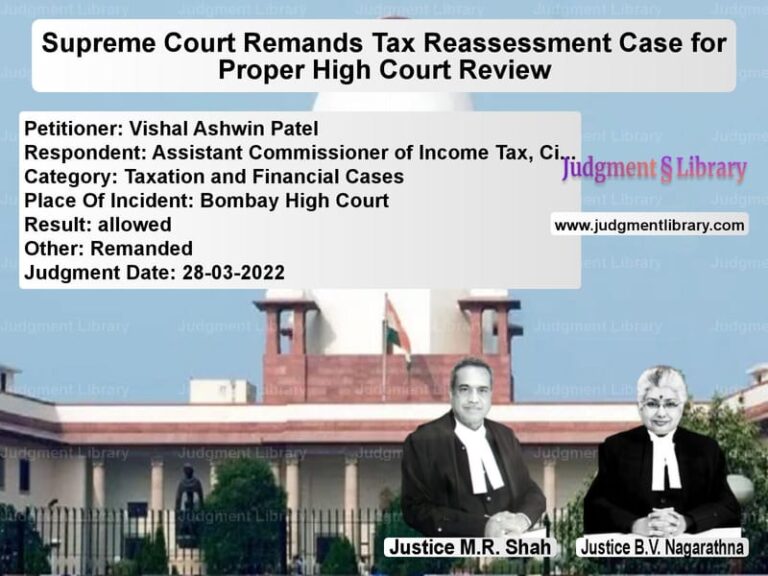Haryana Land Acquisition Case: Supreme Court Upholds Compensation for Landowners
The case of Mohammad Yusuf & Others vs. State of Haryana & Others revolves around a land acquisition dispute concerning the determination of fair compensation for landowners whose lands were acquired by the Haryana government for constructing a Mini Secretariat in Mewat district. The primary issue before the Supreme Court was whether the compensation awarded to the landowners was just and whether the deductions for development charges were reasonable.
The Supreme Court’s ruling in this case provided clarity on the principles for determining fair compensation under the Land Acquisition Act, 1894, and emphasized the importance of considering market value, future potential, and infrastructural advantages when awarding compensation.
Background of the Case
On October 18, 2005, the Government of Haryana issued a notification under Section 4 of the Land Acquisition Act, 1894, acquiring land in Village Ferozpur Namak, Tehsil Nuh, District Mewat, for the construction of a Mini Secretariat. The total land acquired was approximately 372 kanals and 2 marlas (46 acres, 4 kanals, and 2 marlas). A declaration under Section 6 of the Act was issued on May 25, 2006.
The Land Acquisition Collector (LAC) determined the market value of the acquired land at Rs. 16 lakhs per acre. The landowners, dissatisfied with this valuation, filed a reference under Section 18 of the Land Acquisition Act, leading to an enhancement of the compensation by the Reference Court to Rs. 72 lakhs per acre. However, the court applied a 55% development cut and an additional 5% waiting period deduction, reducing the final compensation to Rs. 28.8 lakhs per acre.
Both the landowners and the Haryana government challenged the compensation in the High Court. The landowners sought a higher valuation, arguing that their land had greater commercial and residential potential, while the state sought to lower the awarded compensation. The High Court increased the compensation to Rs. 64.8 lakhs per acre but reduced the development cut to 10%. Dissatisfied with this ruling, the landowners approached the Supreme Court.
Key Legal Issues
- Whether the compensation awarded by the High Court accurately reflected the market value of the acquired land.
- Whether the High Court’s reduction of the development cut from 55% to 10% was justified.
- Whether the acquired land had significant commercial and residential potential warranting a higher valuation.
- Whether the government’s methodology for determining compensation aligned with the principles established under Section 23 of the Land Acquisition Act.
Arguments by the Appellants (Mohammad Yusuf & Others)
- The appellants argued that the High Court failed to consider the future potential of the land, which was located just 0.5 kilometers from Nuh city and within 30 kilometers of Cyber City, Gurgaon.
- They contended that the land had existing infrastructure such as water, electricity, sewer lines, and proximity to major highways, making it suitable for residential and commercial development.
- They claimed that the development cut should have been eliminated or further reduced, as the land already had basic infrastructural facilities.
- The appellants relied on comparable sales transactions, particularly a sale deed dated October 5, 2005, which showed a per-acre land value of Rs. 72 lakhs.
Arguments by the Respondent (State of Haryana)
- The state argued that the compensation determined by the High Court was adequate and based on market value principles.
- The government maintained that the land required significant development, justifying the application of a 10% development cut.
- It was contended that the Reference Court’s initial 55% development cut was necessary to account for the cost of infrastructure such as roads and public services.
- The state also asserted that awarding compensation based solely on sale deeds would lead to inflated valuations, as land transactions vary based on individual circumstances.
Supreme Court’s Observations
The Supreme Court carefully examined the arguments and legal principles involved in determining fair compensation. The key observations were:
- The Land Acquisition Act requires compensation to be based on market value, considering factors such as location, infrastructure, and future potential.
- The sale deed dated October 5, 2005, showing a price of Rs. 72 lakhs per acre, was the most relevant comparable sale transaction, as it was executed just before the acquisition notification.
- While the land had significant infrastructural advantages, some development work was still necessary, justifying the application of a reasonable development cut.
- The High Court’s reduction of the development cut from 55% to 10% was justified, given the existing infrastructure and location advantages.
- Compensation should be fair and equitable to both landowners and the government, ensuring that landowners receive a just equivalent for their loss.
Final Judgment
The Supreme Court upheld the High Court’s ruling and dismissed the appeals filed by the landowners. The key directives were:
- The compensation of Rs. 64.8 lakhs per acre, as determined by the High Court, was affirmed.
- The 10% development cut applied by the High Court was deemed reasonable and legally valid.
- The methodology used to determine compensation aligned with the principles established under the Land Acquisition Act.
- The ruling reinforced that landowners must be fairly compensated but also recognized the state’s need to develop infrastructure.
Legal Significance of the Judgment
This judgment provides clarity on compensation principles under the Land Acquisition Act, emphasizing that:
- Market value determination must consider location, existing infrastructure, and future development potential.
- Development cuts should be applied reasonably, ensuring fair compensation for landowners while accounting for government infrastructure costs.
- Sale deeds can serve as critical evidence in determining market value, but they must be analyzed in the context of overall land conditions.
- Courts must balance the interests of landowners and the government, ensuring that neither party suffers undue hardship.
Impact on Future Cases
The Supreme Court’s decision sets an important precedent for future land acquisition cases in India. It ensures that landowners receive fair compensation based on real market conditions while allowing the government to apply reasonable deductions for development. The ruling reinforces the principle that compensation should be equitable, preventing undervaluation or excessive awards that burden the public exchequer.
Petitioner Name: Mohammad Yusuf & Others.Respondent Name: State of Haryana & Others.Judgment By: Justice R.K. Agrawal, Justice S. Abdul Nazeer.Place Of Incident: Mewat, Haryana.Judgment Date: 16-04-2018.
Don’t miss out on the full details! Download the complete judgment in PDF format below and gain valuable insights instantly!
Download Judgment: Mohammad Yusuf & Oth vs State of Haryana & O Supreme Court of India Judgment Dated 16-04-2018.pdf
Direct Downlaod Judgment: Direct downlaod this Judgment
See all petitions in Property Disputes
See all petitions in Damages and Compensation
See all petitions in Judgment by R K Agrawal
See all petitions in Judgment by S. Abdul Nazeer
See all petitions in dismissed
See all petitions in supreme court of India judgments April 2018
See all petitions in 2018 judgments
See all posts in Civil Cases Category
See all allowed petitions in Civil Cases Category
See all Dismissed petitions in Civil Cases Category
See all partially allowed petitions in Civil Cases Category







